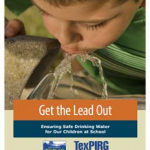Get the Lead Out 2019
Ensuring Safe Drinking Water for Our Children at School
Over the past five years, the tragedy of Flint, Michigan has stunned the nation. We watched the drinking water of an entire city become contaminated with lead. And, we know now that this toxic threat extends well beyond Flint to communities across the country. In fact, test results now show that lead is even contaminating drinking water in schools and pre-schools — flowing from thousands of fountains and faucets where our kids drink water every day. In all likelihood, the confirmed cases of lead in schools’ water are just the tip of the iceberg. Most schools have at least some lead in their pipes, plumbing, or fixtures. And where there is lead, there is risk of contamination.1 The health threat of lead in schools’ water deserves immediate attention from state and local policymakers for two reasons. First, lead is highly toxic and especially damaging to children — impairing how they learn, grow, and behave. So, we ought to be particularly vigilant against this health threat at schools and pre-schools, where our children spend their days learning and playing. Second, current regulations are too weak to protect our children from lead-laden water at school. Federal rules only apply to the roughly ten percent of schools and pre-schools that are considered to be their own Public Water Systems.2 At schools not considered to be a Public Water System, there is no federal rule protecting kids from exposure to lead in schools’ drinking water. While the latest edition of the EPA’s 3Ts for Reducing Lead in Drinking Water in Schools and Child Care Centers recommends that schools reduce lead to the “lowest possible concentration,” unless a state’s law directs schools to adhere to it, this guidance is not enforceable.3 Moreover, even when federal rules do apply to a school, they only require remediation when testing confirms lead concentrations in excess of 15 parts per billion at ten percent or more of taps sampled, even though medical and public health experts agree that there is no safe level of lead for our children.4 The error of this approach is compounded by the fact that testing, even when properly done, often fails to detect maximum lead levels in water coming out of the tap. Unfortunately, so far, most states are failing to protect children from lead in schools’ drinking water. Our review of 32 states’ laws and regulations finds: Several states, including Texas, have no requirements for schools and pre-schools to address the threat of lead in drinking water.
Downloads
TexPIRG

Over the past five years, the tragedy of Flint, Michigan has stunned the nation. We watched the drinking water of an entire city become contaminated with lead. And, we know now that this toxic threat extends well beyond Flint to communities across the country.
In fact, test results now show that lead is even contaminating drinking water in schools and pre-schools — flowing from thousands of fountains and faucets where our kids drink water every day.
In all likelihood, the confirmed cases of lead in schools’ water are just the tip of the iceberg. Most schools have at least some lead in their pipes, plumbing, or fixtures. And where there is lead, there is risk of contamination.1
The health threat of lead in schools’ water deserves immediate attention from state and local policymakers for two reasons. First, lead is highly toxic and especially damaging to children — impairing how they learn, grow, and behave. So, we ought to be particularly vigilant against this health threat at schools and pre-schools, where our children spend their days learning and playing.
Second, current regulations are too weak to protect our children from lead-laden water at school. Federal rules only apply to the roughly ten percent of schools and pre-schools that are considered to be their own Public Water Systems.2 At schools not considered to be a Public Water System, there is no federal rule protecting kids from exposure to lead in schools’ drinking water. While the latest edition of the EPA’s 3Ts for Reducing Lead in Drinking Water in Schools and Child Care Centers recommends that schools reduce lead to the “lowest possible concentration,” unless a state’s law directs schools to adhere to it, this guidance is not enforceable.3 Moreover, even when federal rules do apply to a school, they only require remediation when testing confirms lead concentrations in excess of 15 parts per billion at ten percent or more of taps sampled, even though medical and public health experts agree that there is no safe level of lead for our children.4 The error of this approach is compounded by the fact that testing, even when properly done, often fails to detect maximum lead levels in water coming out of the tap.